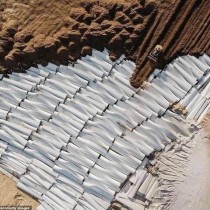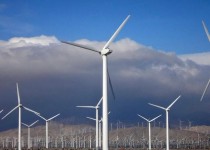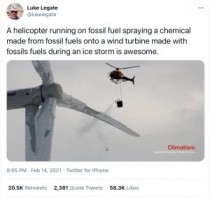That little yellow thing is a bulldozer. It is burying windmill blades used for green energy. Why? Because these blades need to be disposed of and there is presently no way to recycle them. That’s how green energy works!

Who knew? Maybe the people that make them knew. Why would they let that cat out of the bag, after all they are government subsidized with tax payer money. After all It’s all about the money every time! Just like the oil industry powers every electric car.
Also politicians do not want those huge eye sores in their backyard.

Right now the average wind farm is about 150 turbines. Each wind turbine needs 80 gallons of oil as lubricant and we’re not talking about vegetable oil, this is a PAO synthetic oil based on crude… 12,000 gallons of it. That oil needs to be replaced once a year.
It is estimated that a little over 3,800 turbines would be needed to power a city the size of New York… That’s 304,000 gallons of refined oil for just one city.
Now you have to calculate every city across the nation, large and small, to find the grand total of yearly oil consumption from “clean” energy.
Where do you think all that oil is going to come from, the oil fairies? Well thanks to Biden it now comes from our enemies in the Mideast.
Not to mention the fact that the large equipment needed to build these wind farms run on petroleum. As well as the equipment required for installation, service, maintenance, and eventual removal.
And just exactly how eco-friendly is wind energy anyway?
Each turbine requires a footprint of 1.5 acres, so a wind farm of 150 turbines needs 225 acres; In order to power a city the size of NYC you’d need 57,000 acres; and who knows the astronomical amount of land you would need to power the entire US. All of which would have to be clear-cut land because trees create a barrier & turbulence that interferes with the 20mph sustained wind velocity necessary for the turbine to work properly (also keep in mind that not all states are suitable for such sustained winds). Boy, cutting down all those trees is gonna anger a lot of green-loving tree-huggers.
Let’s talk about disposal now.
The lifespan of a modern, top quality, highly efficient wind turbine is 20 years. After that, then what? What happens to those gigantic fiber composite blades?
They cannot economically be reused, refurbished, reduced, repurposed, or recycled so guess what...? It’s off to special landfills they go.
And guess what else..? They’re already running out of these special landfill spaces for the blades that have already exceeded their usefulness. Seriously! Those blades are anywhere from 120 ft. to over 200 ft. long and there are 3 per turbine. And that’s with only 7% of the nation currently being supplied with wind energy. Just imagine if we had the other 93% of the nation on the wind grid...20 years from now you’d have all those unusable blades with no place to put them… Then 20 years after that, and 20 years after that, and so on.
Hello there, how green is that?
Oops, I almost forgot about the 500,000 birds that are killed each year from wind turbine blade collisions; most of which are endangered hawks, falcons, owls, geese, ducks, and eagles.
Apparently smaller birds are more agile and able to dart and dodge out of the way of the spinning blades, whereas the larger soaring birds aren’t so lucky.
I’m sure the wildlife conservationist folks are just ecstatic about that.
I’m so glad the wind energy people are looking out for the world.
Here’s another little problem with windmills-
The generator and switching equipment operate at high power and voltage. Everything in the windmill nacelle is compact due to limited space, so there’s danger of arcs and electrical fires. This is prevented by putting all the electrical equipment in a pressure vessel filled with sulfur hexafluoride, a synthetic gas that has dielectric properties that suppress arcs and fires.
Problem is, windmills leak this gas, something around a pound each per year. SF6 has an atmospheric lifetime of 3,200 years and is 22,800 times more effective as a greenhouse gas than carbon dioxide.
WANT MORE
The wind doesn’t always blow, often on the coldest nights or hottest days. And when ice storms occur as we saw last February in Texas, they freeze and the users are in the dark. Over 100 died last year when temperatures after the snows dropped as cold as 16 below zero in the southern plains.

_thumb.png)




